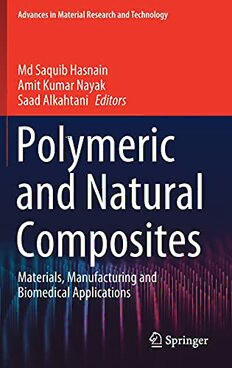
Polymeric and Natural Composites: Materials, Manufacturing and Biomedical Applications PDF
Preview Polymeric and Natural Composites: Materials, Manufacturing and Biomedical Applications
Advances in Material Research and Technology Md Saquib Hasnain Amit Kumar Nayak Saad Alkahtani Editors Polymeric and Natural Composites Materials, Manufacturing and Biomedical Applications Advances in Material Research and Technology SeriesEditor ShadiaJamilIkhmayies,PhysicsDepartment,IsraUniversity,Amman,Jordan ThisSeriescoverstheadvancesanddevelopmentsinawiderangeofmaterialssuch as energy materials, optoelectronic materials, minerals, composites, alloys and compounds, polymers, green materials, semiconductors, polymers, glasses, nano- materials, magnetic materials, superconducting materials, high temperature mate- rials,environmentalmaterials,PiezoelectricMaterials,ceramics,andfibers. Moreinformationaboutthisseriesathttp://www.springer.com/series/16426 · · Md Saquib Hasnain Amit Kumar Nayak Saad Alkahtani Editors Polymeric and Natural Composites Materials, Manufacturing and Biomedical Applications Editors MdSaquibHasnain AmitKumarNayak DepartmentofPharmacy DepartmentofPharmaceutics,Seemanta PalamauInstituteofPharmacy InstituteofPharmaceuticalSciences Daltonganj,Jharkhand,India Mayurbhanj,Odisha,India SaadAlkahtani DepartmentofZoology,College ofScience,KingSaudUniversity Riyadh,SaudiArabia ISSN2662-4761 ISSN2662-477X (electronic) AdvancesinMaterialResearchandTechnology ISBN978-3-030-70265-6 ISBN978-3-030-70266-3 (eBook) https://doi.org/10.1007/978-3-030-70266-3 ©TheEditor(s)(ifapplicable)andTheAuthor(s),underexclusivelicensetoSpringerNature SwitzerlandAG2022 Thisworkissubjecttocopyright.AllrightsaresolelyandexclusivelylicensedbythePublisher,whether thewholeorpartofthematerialisconcerned,specificallytherightsoftranslation,reprinting,reuse ofillustrations,recitation,broadcasting,reproductiononmicrofilmsorinanyotherphysicalway,and transmissionorinformationstorageandretrieval,electronicadaptation,computersoftware,orbysimilar ordissimilarmethodologynowknownorhereafterdeveloped. Theuseofgeneraldescriptivenames,registerednames,trademarks,servicemarks,etc.inthispublication doesnotimply,evenintheabsenceofaspecificstatement,thatsuchnamesareexemptfromtherelevant protectivelawsandregulationsandthereforefreeforgeneraluse. Thepublisher,theauthorsandtheeditorsaresafetoassumethattheadviceandinformationinthisbook arebelievedtobetrueandaccurateatthedateofpublication.Neitherthepublishernortheauthorsor theeditorsgiveawarranty,expressedorimplied,withrespecttothematerialcontainedhereinorforany errorsoromissionsthatmayhavebeenmade.Thepublisherremainsneutralwithregardtojurisdictional claimsinpublishedmapsandinstitutionalaffiliations. ThisSpringerimprintispublishedbytheregisteredcompanySpringerNatureSwitzerlandAG Theregisteredcompanyaddressis:Gewerbestrasse11,6330Cham,Switzerland Preface Polymericcompositesareknownasengineeredmaterialsofhighperformanceand versatility. In general, polymeric composites are designed by employing a combi- nationofmaterialscontainingdifferentphases,atleastoneofwhich,normallythe matrix, is a polymer and the resultant composites possess advantageous mechan- ical and thermal characteristics, which are insufficient to be accomplished by a single polymer. In addition, polymeric composites are capable to facilitate excel- lent friction and wear performances after being modified with functional fillers and reinforcements. The recent trend is to explore naturally derived raw mate- rialsfromvariousrenewableresourcesbecauseofgrowingenvironmentalconcerns over the sustainability of raw materials extracted from synthetic resources for the threattotheecosystemandwell-being.Variousnaturallyderivedrawmaterialsare also becoming more commercialized due to their biodegradability and sustainable production/extractionfromtherenewablenaturalresources.Recently,thesenatural materialsareemployedasusefulrawmaterialsforthemanufacturingofpolymeric composites,whichmakesthesemoreflexiblefortheusesinmanyindustrialappli- cations including biomedical uses. In this context, raw materials, their manufac- turing and biomedical applications (i.e. in drug delivery, growth factor delivery, orthopaedics, dentistry, wound dressing, etc.) of different polymeric and natural compositesneedtobethoroughlyunderstood. Thecurrentbookhighlightstheoverviewandextensiveknowledgeoftheup-to- dateresearchanddevelopmentsofvarioustypesofpolymericandnaturalcompos- ites. Exclusively, it covers the different aspects of raw materials, manufacturing and biomedical applications of polymeric and natural composites by prominent researchersinacademiaandindustryaswellasgovernment/privateresearchlabora- toriesacrosstheworld.Overall,thisbookPolymericandNaturalComposites—Mate- rials,ManufacturingandBiomedicalApplicationswillserveasaholisticreference sourcesuitableforprofessionals,studentsandresearchersfromdifferentdisciplines. The current book is a collection of totally 14 chapters presenting different key topicsbytheacademiciansandresearchersacrosstheworld.Aconciseaccounton thecontentsofeachchapterhasbeendescribedtoprovideaglimpseofthebookto thereaders. v vi Preface Thefirstchapterentitled“NaturalPolymers-BasedBiocomposites:StateofArt, NewChallenges,andOpportunities”describestheroleofdifferentcarbohydratesand protein-based natural polymers along with their physical, chemical and biological properties. The second chapter entitled “Natural Fibre-Reinforced Polymer Composites: ManufacturingandBiomedicalApplications”presentsthemostrelevantandmore recentadvancesinnaturalfibre-reinforcedpolymercomposites,theirmanufacturing andusesinbiomedicalapplications. The third chapter entitled “Polymeric Biocomposites from Renewable and Sustainable Natural Resources” focuses on the use of biocomposites in tissue engineeringandanalyticalapplications.Thestudiedmaterialsincludepolysaccha- ridessuchaschitosan,celluloseandalginate,aswellaspolyhydroxyalcanoatesas matrixes,andfillerslikenanoparticles,carbonnanotubesorpolymers,amongother combinations. The fourth chapter entitled “Polymer/Carbon Nanocomposites for Biomedical Applications” presents a comprehensive survey of the existing and current litera- ture on different aspects of CNTs, their NCs with polymeric materials and their biomedical applications. This chapter also highlights a variety of methods used to produce CNT polymer nanocomposites, along with their characterization tech- niques.Polymernanocomposites(PNCs)basedonCNTsofferremarkablyimproved mechanical,electricalandsensingproperties.Allthisjustifiestheemergentinterestin bothacademiaandindustrialdevelopment.Likewise,thepresentstatusandupcoming possibilitiesofCNT/PNCsareexaminedingeneralalongwithappropriateexamples drawnfromtheexistingliterature. Thefifthchapterentitled“MolecularlyImprintedPolymer—CarbonDotCompos- itesforBiomedicalApplication”dealswiththebiomedicalapplicationofmolecularly imprintedpolymerfunctionalizedcarbondots.Thebriefcharacterizationofcarbon dotsyntheticapproachestogetherwithsummarizedoverviewofimprintingprocess anditslimitationsfollowedbydetaileddiscussionofthecurrentstateoftheartofthe carbondotmolecularlyimprintedpolymerconjugatesforbiomedicinewillprovide insightintothefutureprospectsofthoseadvancedmaterials. The sixth chapter entitled “Magnetic Polymer Nanocomposites: Manufacturing and Biomedical Applications” discusses the current explanation of magnetic nanocompositesfrombasicsciencetothelatestinnovationsasgiven.Startingwith theintroductionofmagnetismandmagneticmaterials,characterizationofmagnetic biomaterials,synthesistechniques,productionmethodsandapplicationareaswere studied.Aneasywaytounderstandnewtechniquesemerginginthisfieldispresented tothereader.Inaddition,morecurrentprocessesandpracticesarebrieflymentioned. The seventh chapter entitled “Jackfruit Seed Starch-Based Composite Beads forControlledDrugRelease”presentsacomprehensivereviewofvariousJSS-based compositebeadsforcontrolledsustainedreleasingofencapsulateddrugs. The eighth chapter entitled “Polymeric Nanocomposites for Cancer-Targeted DrugDelivery”dealswiththepolymericnanocompositesforcancer-targeteddrug delivery, their efficacy and impact on cancer therapy and multiscale molecular simulationstudiesfornanostructuredpolymersystems. Preface vii The nineth chapter entitled “Biopolymeric-Inorganic Composites for Drug Delivery Applications” focuses on the use of biopolymeric–inorganic composites inthepreparationofdrugdeliverysystems.Thetypesofbiopolymericandinorganic materialsthatcanbecombinedintocompositematerialsandtheircharacteristicsare summarizedherein.Thegivenmaterialsarejustexamplesforthecompositemate- rialsofinterest,andmanyothercompositescanbesynthesizedfromdifferenttypes ofinorganicandbiopolymericmaterials. The tenth chapter entitled “Natural Polymeric-Based Composites for Delivery of Growth Factors” deals with the different natural polymer-based composites for growthfactordelivery. The eleventh chapter entitled “Biopolymers/Ceramic-Based Nanocomposite ScaffoldsforDrugDeliveryinBoneTissueEngineering”presentsadistinctvariety of biopolymer–ceramic-based nanocomposite scaffolds for drug delivery in bone tissueengineering. The twelfth chapter entitled “Biopolymeric Nanocomposites for Orthopedic Applications”summarizestherecentresearchresultsonthedevelopmentandappli- cations of various types of biopolymeric nanocomposites utilized in prosthetic devicestobonegrafts,forcelldelivery,withaspecialfocusonmaterialtype,formu- lations,currentdesignandperformanceinbonetissueengineering.Importantchal- lenges related to the degradation of biopolymeric nanocomposite scaffolds, wide rangeofpropertiesandbenefitsforbonehealingareaddressed. Thethirteenthchapterentitled“NaturalPolymer-BasedCompositeWoundDress- ings”scrutinizestheevolutionofnaturalpolymersinwounddressingfromtraditional tomodern-daytreatmentmethods.Themajorpropertyofanaturalpolymerwhich iswidelyutilizedasbiomaterialsispresented.Propertiesofcompositematerialwith peculiarheedontheirapplicationsintheskintissuerepairfieldarediscussed.Finally, theunmetneedsanddevelopmentalprospectivesofthenewgenerationsofenviron- mentallyfriendly,naturallyderived,smartwounddressingsareaddressedinthelight offutureresearch. Thefourteenthchapterentitled“AViewonPolymer-BasedCompositeMaterials forSmartWoundDressings”presentsanoverviewonthechallengesandcomplexity ofachronicwound,exploringtheeventofawoundinfectionanddiscussingthelarge range of polymer-based composite materials and products in use for each specific woundcondition,takingintoaccountthekeydecisionaspectsdefinedbytheclin- icians.Differenttissueengineeringstrategiesarealsohereinaddressedwithvaried reported clinical success, ranging from non-cellularized to considerably sophisti- catedcellularizedproducts,reproducingthecompositionalcomplexityofbothdermis andepidermis.Recentadvancesinsmartdressingsandsensorsarealsobroughtto discussionassensingthewoundcangiveusnewinsightsabouttheseriesofcomplex biochemicaleventsrelatedtothehealingandregenerationprocess,whilecontributing forabetterwoundassessment. We would like to convey our sincere thanks to all the authors of the chap- ters for providing timely and valuable contributions. We thank the publisher— Springer Nature. We specially thank Dr. Shadia Jamil Ikhmayies (Series Editor, AdvancesinMaterialResearchandTechnology,SpringerNature),MayraCastroand viii Preface BoopalanRenufortheirinvaluablesupportinorganizationoftheeditingprocessright throughthebeginningtofinishingpointofthisbook.Wegratefullyacknowledgethe permissionstoreproducecopyrightmaterialsfromvarioussources.Finally,wewould like to thank our family members, all respected teachers, friends, colleagues and dearstudentsfortheircontinuousencouragements,inspirationsandmoralsupports during the preparation of the current book. Together withour contributing authors andthepublishers,wewillbeextremelypleasedifourendeavourfulfilstheneeds ofacademicians,researchers,students,biomedicalexperts,pharmaceuticalstudents anddrugdeliveryformulators.Inanutshell,itwillalsohelpthehealthprofessionals inacademiaaswellasintheindustries. Jharpokharia,India Dr.AmitKumarNayak Daltonganj,India Dr.MdSaquibHasnain Riyadh,SaudiArabia Dr.SaadAlkahtani Contents Natural Polymers-Based Biocomposites: State of Art, New Challenges,andOpportunities ...................................... 1 LaxmikantGautam,AnamikaJain,PriyaShrivastava,SonalVyas, andSureshP.Vyas NaturalFibre-ReinforcedPolymerComposites:Manufacturing andBiomedicalApplications ....................................... 25 TielidyA.deM.deLima, GabrielGoettendeLima, andMichaelJ.D.Nugent Polymeric Biocomposites from Renewable and Sustainable NaturalResources ................................................. 65 DanielaM.Fidalgo, MarioD.Contin, AdrianaA.Kolender, andNormaD’Accorso Polymer/CarbonNanocompositesforBiomedicalApplications ......... 109 JyotendraNath,KashmaSharma,ShashikantKumar,VijayKumar, andRakeshSehgal Molecularly Imprinted Polymer—Carbon Dot Composites forBiomedicalApplication ......................................... 151 MonikaSobiechandPiotrLulin´ski Magnetic Polymer Nanocomposites: Manufacturing andBiomedicalApplications ....................................... 187 HüsnügülYilmazAtay Jackfruit Seed Starch-Based Composite Beads for Controlled DrugRelease ...................................................... 213 AmitKumarNayak,SaadAlkahtani,andMdSaquibHasnain ix
